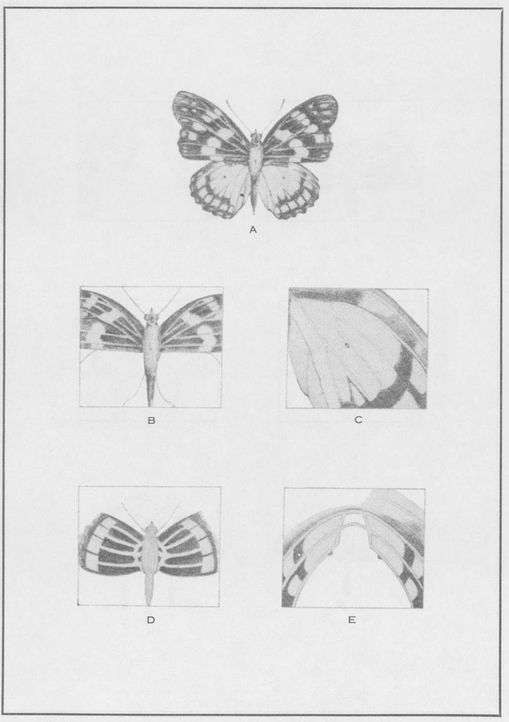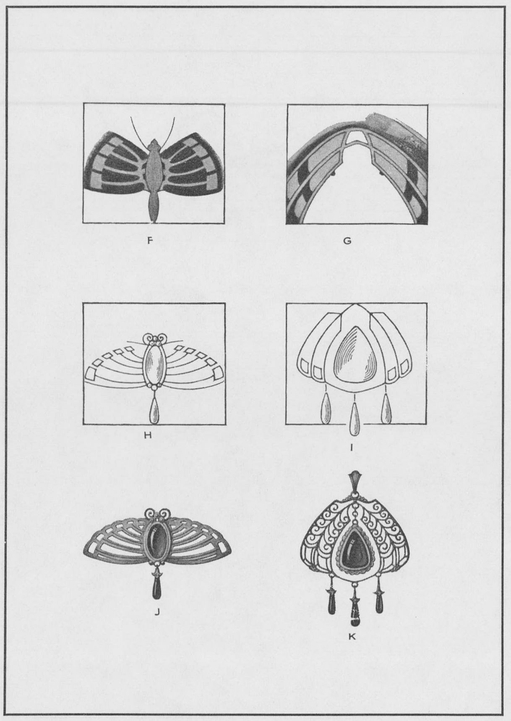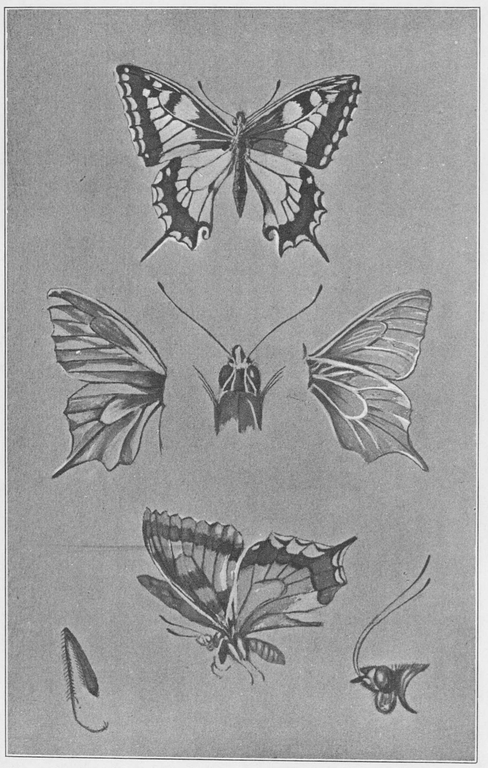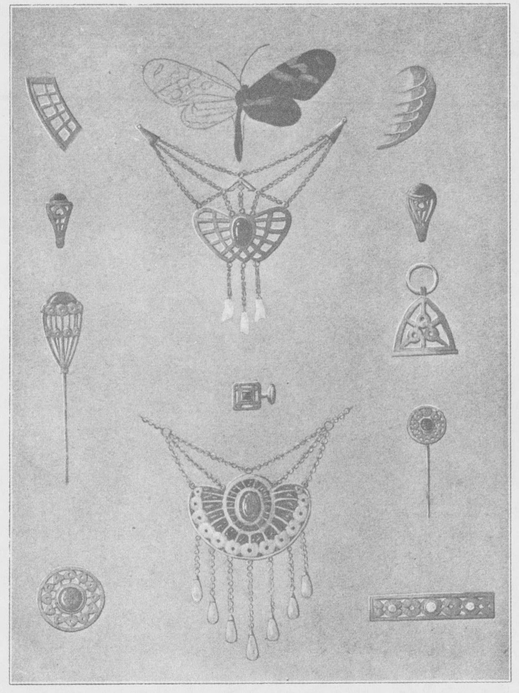CHAPTER 32
The Butterfly in Design
DESIGNING from the butterfly or from any of the sources of nature involves on the part of the student not only ability to see motifs which the untrained would not see but also the ability to interpret such motifs in terms of design. Copying from the different sources of nature in the foregoing problems was not suggested to the student that he might hope in the course of time to find ready-made designs. The subjects chosen were given to inculcate a feeling of balance, rhythm, beautiful proportion, and harmony of line and shape, the principles which the student will learn to use in his production of designs. While studying nature, the student should strive to keep these principles in mind, or better, to make notes of them as he goes along; and unless this is done with active attention and real interest, the study will be done merely for its own sake and the vital aim of the problem will be entirely missed.
When designing from nature the student is asked to make an exact copy, either in pencil or brush, as shown by the illustrations (page 261, fig. A, and page 263), in order to gain a wider appreciation of its rhythmic lines and shapes, harmonious color, and balance or symmetry of spots. Butterflies with beautiful spots will be found very suggestive for ideas. The student may prove himself to be very skillful in this and yet be utterly unable to make up a design of the crudest sort even after shown examples and illustrated work. The novice cannot see how this insignificant weed or that worthless seed pod was enough to suggest so many beautiful designs. Even though the students be shown where the different designs came from, which part of the flower suggested this design and which that, they cannot make them unless a didactic method of instruction is offered.
Pages 261 and 262 show just the way the designer thinks when confronted with this problem. Page 261, fig. A is a very careful pencil drawing of the butterfly, showing all detail. Fig. B shows a unit that apparently has possibilities of suggesting an idea. Fig. D shows that the unit has been simplified, thereby becoming a formal representation of this part of the fly. On page 262, fig. H still bears the characteristic features of fig. D, but with much more formality. The lines representing the ribs of the fly have been increased in number and the upward rhythmic movement has been accented. The rectangular spots at the ends of these lines have correspondingly been increased and modified to carry out the upward direction of the lines. The upper part of the body of the fly has given way to a stone while the lower part has been replaced by a drop. The head conveniently made way for three circles which might be granulations while the antennae are curled into involute curves around the three circles. The design thus far is in abstract terms, no thought having been given to the method of execution, the aim being first to produce an arrangement with no idea as to practicalities. Fig. J shows how such a composition of lines and masses can be reconstructed or interpreted in terms of metal and some definite process of execution. The result here attained is for a pierced brooch although it might have been made for enamel or even for the repoussé process.

Butterflies, a visual aid to stimulate ideas in jewelry design
Page 261, fig. C is another part of the same fly. Part of this was taken and reversion is resorted to as shown by fig. E. By this simple process of reversion we have created a series of lines radiating downward to left and right from a common axis. Familiarity with jewelry suggested a hanging of some kind, a pendant possibly. Hence on page 262, fig. I expresses the same downward effect of these lines with some modification of the ends and the spots between the lines. These lines created an open space and it was taken advantage of by inserting a stone that suggests its shape. The three drops were added to emphasize the downward effect of the pendant. This design, like page 262, fig. H, is merely in abstract terms. It is a cluster of lines radiating downward from a vertical axis. The design is now to be interpreted in terms of metal, stones, and a tool process. Fig. K shows that it has been interpreted in fine wire. The spaces between the main lines of the design have been filled in with scrolls since they looked empty and unattractive. The other modifications and additions have been made to create a harmonious whole. The result is a total design for a jewel which the layman marvels at, wondering how unit B or C was the origin of that beautiful design. A collection of butterflies such as page 259 is invaluable for this kind of work. Page 263 shows studies made from a butterfly in this collection while on page 264 are a number of designs evolved from the butterfly.

Sections of the butterfly enlarged, symmetrized and processed in terms of design principles

Simple steps from the processed design principle to the finished design

Motif suggestions from enlarged details of the butterfly

Designs extracted from details of the butterfly
The question may now arise as to whether it is necessary for the student to have some knowledge of the making of jewelry in order to design practical jewelry and do it with facility. Of course it would be of great help to know how the jewel is put together but it is not absolutely necessary. When the student has familiarized himself with jewelry processes, and has some creative ability, he should be able to produce good results.
When the student has grasped the method of attacking the problem, or better, the method of interpreting units for design, he is beginning to develop creative power that can evolve designs from almost anything. Just as soon as the student is able to look at any part or unit of the butterfly and see in it endless possibilities in design, he will never be hampered for ideas, he will see more possibilities in a single motif than ever before, and his pencil will not work fast enough to record these ideas.
If this method of designing is followed, the student will never be wanting in ideas. Designing from nature will render the ideas free from strain and overlabor; they will look fresh, possess a feeling that will tell that they were done with freedom and spontaneity.